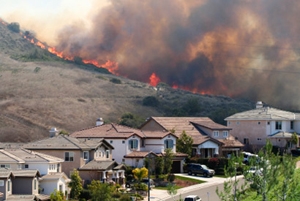Climate change will alter risk of wildfire worldwide
Climate change is widely expected to disrupt future fire patterns around the world, with some regions, such as the western United States, seeing more frequent fires within the next 30 years, according to a new analysis led by researchers at the University of California, Berkeley, in collaboration with an international team of scientists.
By the end of the century, almost all of North America and most of Europe is projected to see a jump in the frequency of wildfires, primarily because of increasing temperature trends. At the same time, fire activity could actually decrease around equatorial regions, particularly among the tropical rainforests, because of increased rainfall.
The study, to be published Tuesday, June 12, in Ecosphere, an open-access, peer-reviewed journal of the Ecological Society of America, used 16 different climate change models to generate what the researchers said is one of the most comprehensive projections to date of how climate change might affect global fire patterns.
"In the long run, we found what most fear — increasing fire activity across large parts of the planet," said study lead author Max Moritz, fire specialist in UC Cooperative Extension. "But the speed and extent to which some of these changes may happen is surprising."
"These abrupt changes in fire patterns not only affect people's livelihoods," Moritz added, "but they add stress to native plants and animals that are already struggling to adapt to habitat loss."
The projections emphasize how important it is for experts in conservation and urban development to include fire in long-term planning and risk analysis, added Moritz, who is based at UC Berkeley’s College of Natural Resources.
UC Berkeley researchers worked with an atmospheric scientist from Texas Tech University to combine over a decade of satellite-based fire records with historical climate observations and model simulations of future change. The authors documented gradients between fire-prone and fire-free areas of Earth, and quantified the environmental factors responsible for these patterns. They then used these relationships to simulate how future climate change would drive future fire activity through the coming century as projected by a range of global climate models.
"Most of the previous wildfire projection studies focused on specific regions of the world, or relied upon only a handful of climate models," said study co-author Katharine Hayhoe, associate professor and director of the Climate Science Center at Texas Tech University. "Our study is unique in that we build a forecast for fire based upon consistent projections across 16 different climate models combined with satellite data, which gives a global perspective on recent fire patterns and their relationship to climate."
The fire models in this study are based on climate averages that include mean annual precipitation and mean temperature of the warmest month. These variables tend to control long-term biomass productivity and how flammable that fuel can get during the fire season, the researchers said.
Variables that reflect more ephemeral fluctuations in climate, such as annual rainfall shifts due to El Niño cycles, were not included because they vary over shorter periods of time, and future climate projections are only considered representative for averages over time periods of 20-30 years or longer, the authors said.
The study found that the greatest disagreements among models occur for the next few decades, with uncertainty across more than half the planet about whether fire activity will increase or decrease. However, some areas of the world, such as the western United States, show a high level of agreement in climate models both near-term and long-term, resulting in a stronger conclusion that those regions should brace themselves for more fire.
"When many different models paint the same picture, that gives us confidence that the results of our study reflect a robust fire frequency projection for that region," said Hayhoe. "What is clear is that the choices we are making as a society right now and in the next few decades will determine what Earth’s climate will look like over this century and beyond."
Study co-author David Ganz, who was director of forest carbon science at The Nature Conservancy at the time of the study, noted the significance of the findings for populations that rely upon fire-sensitive ecosystems.
"In Southeast Asia alone, there are millions of people that depend on forested ecosystems for their livelihoods," he said. "Knowing how climate and fire interact are important factors that one needs to consider when managing landscapes to maintain these ecosystem goods and services."
The researchers noted that the models they developed focused on fire frequencies, and that linking these to other models of fire intensity and vegetation change are important next steps.
"Our ability to model fire activity is improving," said Moritz, "but a more basic challenge is learning to coexist with fire itself."
The Natural Sciences and Engineering Research Council of Canada, the U.S. Forest Service, the National Science Foundation and The Nature Conservancy helped support this study.
RELATED INFORMATION
- Climate change to spur rapid shifts in fire hotspots, projects new analysis (2009 UC Berkeley press release)

